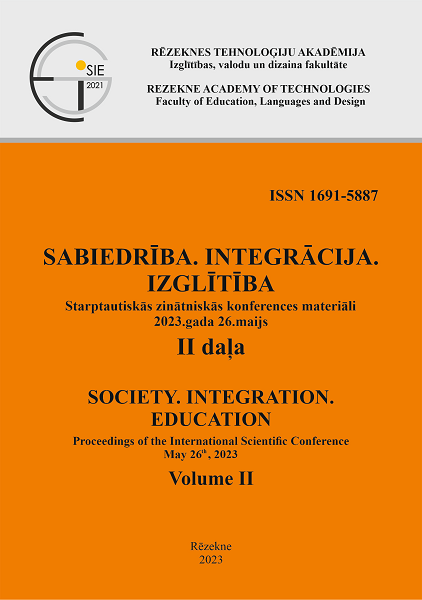PEDAGOGICAL POTENTIAL OF A PICTURE TO ENHANCE SPEECH FOR CHILDREN WITH LANGUAGE DISORDERS
DOI:
https://doi.org/10.17770/sie2023vol2.7101Keywords:
language, language disorders, picture as method, speechAbstract
The scientist A. Leontyev assures that the language competence is the result of development of continuous use of each language. Only through active communication and active speech activity an understanding about language emerges for the child (Leontyev, 1977). The scientist Glukhov (2005) outlines the skill to improve the language abilities by performing the speech activity in the process of communication. Whereas, one of the most significant factors in the process of mastering the language is a positive emotional background, where the child is encouraged to perceive visible, apparent things, living beings, natural phenomena, to listen and pronounce words which designate them. This also inspires to investigate the pedagogical potential of a picture to enhance speech for children with language disorders.
The picture is a significant visual aid for a child not only to be taught but also to have fun for improving the language skills. Therefore, it is worked out a set of pictures as a help for the parents to work with a child at home. In a such way a speech therapist is involving the parents in a teaching process to prolong an educational process with a child. As a result, the parents get a pedagogic experience and the efficient development for a child language.
References
Dēķens, K. (1919). Rokas grāmata pedagoģijā. Rīga, 238 lpp.
Eden, R. (1994). The Hutchinson Dictionary of Ideas. Anne – Lucie Norton: Helicon Publishing Ltd., 583 p.
Fomina, A. (1984). Fizkul'turnye zanjatija i sportivnye igry v detskom sadu. Moskva: Prosveshhenie, Str. 158
Geske, R. (2005). Bērna bioloģiskā attīstība. Rīga: RaKa, 314 lpp.
Hibnere, V. (2000). Bērna vizuālā darbība. I daļa. Rīga: RaKa, 198 lpp.
Labklājības ministrija. (2023). Gada dati. Pieejams: https://www.lm.gov.lv/lv/gada-dati
Lieģeniece, D. (1999). Kopveseluma pieeja audzināšanā. Rīga: RaKa, 400 lpp.
Liepiņa, S. (2008). Speciālā psiholoģija. Rīga: RaKa, 397 lpp.
Loks, D. (1977). Eseja par cilvēka sapratni. Rīga: Zvaigzne.
Miltiņa, I. (2005). Skaņu izrunas traucējumi. Rīga: RaKa.
Montessori, M. (1965). The Advanced Montessori Method. India, Madras: Kalakshetra Publications, 294 p.
Oficiālais statistikas portals. (2019). Pirmsskolas. Pieejams: https://stat.gov.lv/lv/statistikas-temas/izglitiba-kultura-zinatne/pirmsskolas-izglitiba/cits/5592-pirmsskolas?themeCode=IN
Pestalocijs, J. H. (1996). Darbu izlase: Veltīta pedagoga 250. gadu atcerei. Izd. Klauss Altermans un Anita Čaure: No vācu val. tulkojusi A.Čaure. Rīga: Latvijas Universitāte, Pedagoģijas studijas 2. grāmata. 140 lpp.
Puškarevs, J., & Golubeva, A. (2000). Bērna attīstība. Lielvārde: Lielvārds, 119 lpp.
Randoha, A. (2015). Pirmsskolēna pašizteikšanās zīmētdarbībā. Bērna sasniegumu veicināšana pirmsskolā (150.-186. lpp.). Rīga: RaKa.
Students, J. A. (1935). Bērna, pusaudža un jaunieša psiholoģija. Rīga: Autora izdevumā, 735 lpp.
Svence, G. (2011). Bērna valodas un runas attīstība pirmsskolas un jaunākās skolas vecumā. Tagad (25.-30. lpp.). LVA zinātniski metodisks izdevums Nr. 1.
Špona A., & Jermolajeva J. (2015) Bērns, Bērnība. Sasniegumu pētīšana. Bērna sasniegumu veicināšana pirmsskolā (8.-24. lpp.). Rīga: RaKa.
Tūbele, S., & Šteinberga, A. (2004). Ievads speciālajā pedagoģijā. Rīga: RaKa, 112 lpp.
Vigotskis, L. (2002). Domāšana un runa. Rīga: Eve, 392 lpp.
Vigotskis, L. (1997). Voobrazhenie i tvorchestvo v detskom vozraste. Sankt-Peterburg: Sojuz, Str. 91
Yermakova, T. S., & Podolski, A. (2019). Pedagogical approach to the development of art therapy. International Scientific Information, Inc., pp. 171-179.






